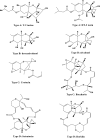T-2 mycotoxin: toxicological effects and decontamination strategies
- PMID: 28430618
- PMCID: PMC5464924
- DOI: 10.18632/oncotarget.15422
T-2 mycotoxin: toxicological effects and decontamination strategies
Abstract
Mycotoxins are highly diverse secondary metabolites produced in nature by a wide variety of fungus which causes food contamination, resulting in mycotoxicosis in animals and humans. In particular, trichothecenes mycotoxin produced by genus fusarium is agriculturally more important worldwide due to the potential health hazards they pose. It is mainly metabolized and eliminated after ingestion, yielding more than 20 metabolites with the hydroxy trichothecenes-2 toxin being the major metabolite. Trichothecene is hazardously intoxicating due to their additional potential to be topically absorbed, and their metabolites affect the gastrointestinal tract, skin, kidney, liver, and immune and hematopoietic progenitor cellular systems. Sensitivity to this type of toxin varying from dairy cattle to pigs, with the most sensitive endpoints being neural, reproductive, immunological and hematological effects. The mechanism of action mainly consists of the inhibition of protein synthesis and oxidative damage to cells followed by the disruption of nucleic acid synthesis and ensuing apoptosis. In this review, the possible hazards, historical significance, toxicokinetics, and the genotoxic and cytotoxic effects along with regulatory guidelines and recommendations pertaining to the trichothecene mycotoxin are discussed. Furthermore, various techniques utilized for toxin determination, pathophysiology, prophylaxis and treatment using herbal antioxidant compounds and regulatory guidelines and recommendations are reviewed. The prospects of the trichothecene as potential hazardous agents, decontamination strategies and future perspectives along with plausible therapeutic uses are comprehensively described.
Keywords: apoptosis; decontamination; herbal antioxidant compounds; oxidative damage; trichothecenes.
Conflict of interest statement
The authors declare no conflict of interest.
Figures







References
-
- Zain ME. Impact of mycotoxins on humans and animals. J Saudi Chem Soc. 2011;15:129–144.
-
- Fink-Gremmels J, Georgiou NA. Risk assessment of Mycotoxins for the consumer. In: Ennen G, Kuiper H.A, Valentin A, editors. Residues of Veterinary Drugs and Mycotoxins in Animal Products. NL-Wageningen Press; 1996. pp. 159–174.
-
- Kuiper-Goodman T. Food Safety: Mycotoxins and Phytotoxins in Perspective. In: Miraglia M, van Egmond H, Brera C, Gilbert J, editors. Mycotoxins and Phycotoxins - Develop Chem Toxicol Food Safety. Rome, Italy: 1998. pp. 25–48.
-
- Kalantari H, Zong MS, Chang IM. Assay of T-2 toxin contamination in domestic and imported agricultural products in Korea. Proc Jpn Assoc Mycotoxicol. 1989;30:32–34.
-
- Kalantari H, Hematti AA. Antidote for T-2 toxin from medicinal plants in mice. Hakim Res J Nat Res Center Med Sci. 2000:4.
Publication types
MeSH terms
Substances
LinkOut - more resources
Full Text Sources
Other Literature Sources

